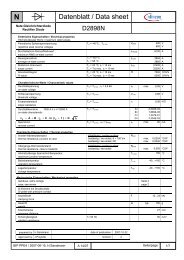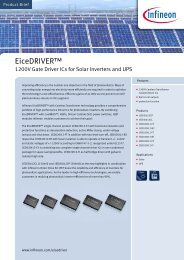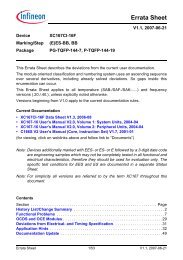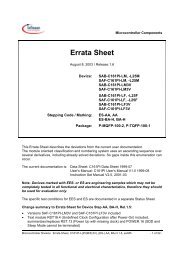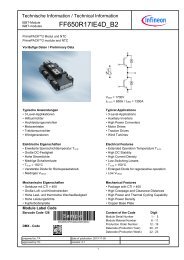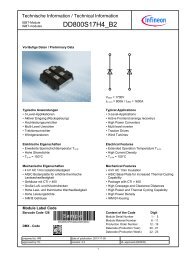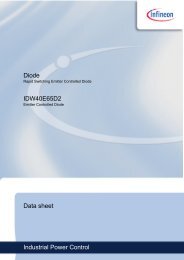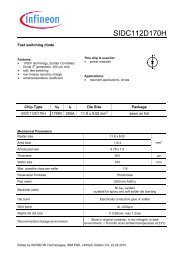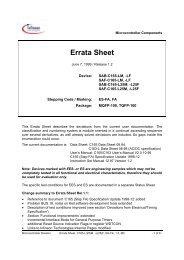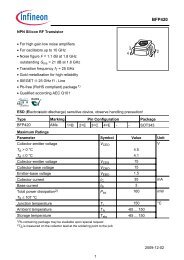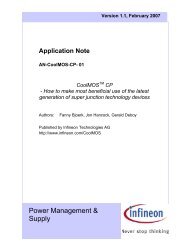Application Note 650V CoolMOS™ C7 Mastering the Art of Quickness
Application Note 650V CoolMOS™ C7 Mastering the Art of Quickness
Application Note 650V CoolMOS™ C7 Mastering the Art of Quickness
Create successful ePaper yourself
Turn your PDF publications into a flip-book with our unique Google optimized e-Paper software.
<strong>Application</strong> <strong>Note</strong> AN 2013-04<br />
V1.0 April 2013<br />
C o o l M O S C 7 : M a s t e r i n g t h e A r t o f Q u i c k n e s s<br />
A T e c h n o l o g y D e s c r i p t i o n a n d D e s i g n G uide<br />
Infineon Technologies<br />
Hancock J.<br />
Stueckler F.<br />
Vecino E.
CoolMOS <strong>C7</strong> Technology and Design Guide<br />
<strong>Application</strong> <strong>Note</strong> AN 2013-04<br />
V1.0 April 2013<br />
Edition 2013-04-25<br />
Published by<br />
Infineon Technologies Austria AG<br />
9500 Villach, Austria<br />
© Infineon Technologies Austria AG 2013.<br />
All Rights Reserved.<br />
Attention please!<br />
THE INFORMATION GIVEN IN THIS APPLICATION NOTE IS GIVEN AS A HINT FOR THE IMPLEMEN-<br />
TATION OF THE INFINEON TECHNOLOGIES COMPONENT ONLY AND SHALL NOT BE REGARDED AS<br />
ANY DESCRIPTION OR WARRANTY OF A CERTAIN FUNCTIONALITY, CONDITION OR QUALITY OF<br />
THE INFINEON TECHNOLOGIES COMPONENT. THE RECIPIENT OF THIS APPLICATION NOTE MUST<br />
VERIFY ANY FUNCTION DESCRIBED HEREIN IN THE REAL APPLICATION. INFINEON<br />
TECHNOLOGIES HEREBY DISCLAIMS ANY AND ALL WARRANTIES AND LIABILITIES OF ANY KIND<br />
(INCLUDING WITHOUT LIMITATION WARRANTIES OF NON-INFRINGEMENT OF INTELLECTUAL<br />
PROPERTY RIGHTS OF ANY THIRD PARTY) WITH RESPECT TO ANY AND ALL INFORMATION GIVEN<br />
IN THIS APPLICATION NOTE.<br />
Information<br />
For fur<strong>the</strong>r information on technology, delivery terms and conditions and prices please contact your nearest Infineon<br />
Technologies Office (www.infineon.com).<br />
Warnings<br />
Due to technical requirements components may contain dangerous substances. For information on <strong>the</strong> types in<br />
question please contact your nearest Infineon Technologies Office. Infineon Technologies Components may only be<br />
used in life-support devices or systems with <strong>the</strong> express written approval <strong>of</strong> Infineon Technologies, if a failure <strong>of</strong><br />
such components can reasonably be expected to cause <strong>the</strong> failure <strong>of</strong> that life-support device or system, or to affect <strong>the</strong><br />
safety or effectiveness <strong>of</strong> that device or system. Life support devices or systems are intended to be implanted in <strong>the</strong><br />
human body, or to support and/or maintain and sustain and/or protect human life. If <strong>the</strong>y fail, it is reasonable to<br />
assume that <strong>the</strong> health <strong>of</strong> <strong>the</strong> user or o<strong>the</strong>r persons may be endangered.<br />
AN 2013-04<br />
Revision History: date (13-04-25) , V1.0<br />
Previous Version: none<br />
Subjects: Release <strong>of</strong> application note<br />
Authors: Hancock Jon (IFNA PMM SMD AMR PMD)<br />
Stueckler Franz (IFAT PMM APS SE SL)<br />
Vecino-Vazquez Enrique (IFAG PMM DPC HVM)<br />
We Listen to Your Comments<br />
Any information within this document that you feel is wrong, unclear or missing at all? Your feedback will help us to<br />
continuously improve <strong>the</strong> quality <strong>of</strong> this document. Please send your proposal (including a reference to this<br />
document) to: [jon.hancock@infineon.com; franz.stueckler@infineon.com; enrique.vecino@infineon.com]<br />
2
CoolMOS <strong>C7</strong> Technology and Design Guide<br />
<strong>Application</strong> <strong>Note</strong> AN 2013-04<br />
V1.0 April 2013<br />
Table <strong>of</strong> contents<br />
1 Introduction .................................................................................................................................................. 4<br />
2 Towards <strong>the</strong> ideal <strong>650V</strong> silicon MOSFET switch: Superjunction (SJ) principle ................................... 4<br />
3 Technology comparison <strong>of</strong> CoolMOS CP, C6, and <strong>C7</strong> ......................................................................... 6<br />
3.1 Electrical characteristics: General Overview ..................................................................................... 6<br />
3.2 The gate charge improvement ........................................................................................................... 7<br />
3.3 The E oss improvement ........................................................................................................................ 8<br />
3.4 The improvement <strong>of</strong> <strong>the</strong> capacitance pr<strong>of</strong>iles .................................................................................... 9<br />
4 Benefits <strong>of</strong> <strong>C7</strong> in <strong>the</strong> switching losses and <strong>the</strong> overall efficency......................................................... 11<br />
4.1 Switching losses <strong>of</strong> CoolMOS C6, CP and <strong>C7</strong> ............................................................................. 11<br />
4.2 The trade-<strong>of</strong>f between switching losses and conduction losses ...................................................... 11<br />
4.3 Efficiency benefits ............................................................................................................................ 13<br />
5 Fur<strong>the</strong>r considerations on <strong>the</strong> dynamic switching behavior <strong>of</strong> CoolMOS TM <strong>C7</strong> ................................. 14<br />
5.1 Gate controlled MOSFET switching ................................................................................................. 15<br />
5.2 Quasi-ZVS turn-<strong>of</strong>f switching (C oss -limited)...................................................................................... 18<br />
5.3 Turn <strong>of</strong>f di/dt ..................................................................................................................................... 19<br />
5.4 Turn <strong>of</strong>f dv/dt .................................................................................................................................... 21<br />
6 Circuit design and layout recommendations ......................................................................................... 22<br />
6.1 Why MOSFETs can be susceptible to oscillations during switching ............................................... 22<br />
6.2 Layout - Avoid stray coupling capacitance between drain and gate................................................ 23<br />
6.3 Control gain and dv/dt and di/dt by proper selection <strong>of</strong> gate resistor .............................................. 24<br />
6.4 Improved gate damping <strong>of</strong> <strong>C7</strong> compared with CP ........................................................................... 26<br />
6.5 For fast switching circuits and problematic layouts, use a ferrite bead ........................................... 28<br />
7 Conclusions ............................................................................................................................................... 29<br />
8 List <strong>of</strong> abbreviations ................................................................................................................................. 29<br />
9 References ................................................................................................................................................. 30<br />
3
CoolMOS <strong>C7</strong> Technology and Design Guide<br />
<strong>Application</strong> <strong>Note</strong> AN 2013-04<br />
V1.0 April 2013<br />
1 Introduction<br />
This application note describes <strong>the</strong> characteristics <strong>of</strong> CoolMOS <strong>C7</strong>, <strong>the</strong> newest high voltage superjunction<br />
MOSFET technology from Infineon, which features major advances in component metrics and achievable<br />
application performance. CoolMOS <strong>C7</strong> will be described in reference to existing CoolMOS generations<br />
from a technology viewpoint, and also with respect to application performance. <strong>Application</strong> guidelines will be<br />
given for achieving high performance in standard hard switching SMPS topologies with robust designs with<br />
safe operation.<br />
2 Towards <strong>the</strong> ideal <strong>650V</strong> silicon MOSFET switch: superjunction (SJ)<br />
principle<br />
For conventional high-voltage MOSFETs, <strong>the</strong> voltage blocking capability in <strong>the</strong> drain drift region is developed<br />
through <strong>the</strong> combination <strong>of</strong> a thick epitaxial region and light doping. This results in about 95% <strong>of</strong> <strong>the</strong> device<br />
resistance in <strong>the</strong> drain region, which cannot be improved by <strong>the</strong> approaches used for low-voltage transistors<br />
(trench cells with smaller cell pitch), where only about 30% <strong>of</strong> <strong>the</strong> transistor resistance is in <strong>the</strong> drain drift<br />
region.<br />
The intrinsic resistance <strong>of</strong> a conventional epitaxial drift region <strong>of</strong> optimum doping pr<strong>of</strong>ile for a given blocking<br />
voltage class is shown in Figure 2 as <strong>the</strong> “silicon limit line,” which, in <strong>the</strong> past, has been a barrier to improved<br />
performance in high-voltage MOSFETs. Chen and Hu <strong>the</strong>oretically derived this limit line in <strong>the</strong> late 1980’s<br />
[1]. This aspect <strong>of</strong> MOSFET design and physics limited achievable performance until <strong>the</strong> introduction <strong>of</strong><br />
CoolMOS by Siemens (now Infineon), <strong>the</strong> first commercially available superjunction MOSFETs [2,3].<br />
Figure 1: Conventional HV planar MOSFET and superjunction MOSFET cross section<br />
In 1999, CoolMOS TM first employed a novel drain structure employing <strong>the</strong> superjunction concept (Figure 1).<br />
There are two key principles employed in this transistor design. First, <strong>the</strong> main current path is much more<br />
heavily doped than for a conventional high-voltage MOSFET. This lowers <strong>the</strong> on-state resistance. But<br />
without <strong>the</strong> p-columns forming a charge compensation structure below <strong>the</strong> cell structure <strong>the</strong> transistor would<br />
have a much lower blocking voltage capability due to <strong>the</strong> highly doped n-region. The precisely sized and<br />
doped p-columns constitute a “compensation structure”, which balances <strong>the</strong> heavily doped current path and<br />
supports a space charge region with zero net charge supporting high blocking voltage.<br />
4
CoolMOS <strong>C7</strong> Technology and Design Guide<br />
<strong>Application</strong> <strong>Note</strong> AN 2013-04<br />
V1.0 April 2013<br />
Figure 2: Silicon Limit line and area specific R DS(on) versus blocking voltage capabilities <strong>of</strong><br />
CoolMOS C3, CP, C6, E6, CE and <strong>C7</strong> compared noting advances with subsequent generations<br />
This construction enables a reduction in area specific resistance which has obvious conduction loss benefits<br />
- <strong>the</strong> attendant remarkable reduction in chip area for <strong>the</strong> first generation <strong>of</strong> CoolMOS technology lowered<br />
capacitance and dynamic losses as well through <strong>the</strong> reduction <strong>of</strong> chip area and capacitance. This technology<br />
made it possible to “beat” <strong>the</strong> silicon limit line (Figure 2) and, with a new finer pitch generation in CoolMOS<br />
CP, to fur<strong>the</strong>r improve all aspects <strong>of</strong> losses [4,5].<br />
This MOSFET technology approach has now been fur<strong>the</strong>r extended with <strong>the</strong> development <strong>of</strong> CoolMOS<br />
<strong>C7</strong>, which reduces <strong>the</strong> typical area specific R DS(on) down below <strong>the</strong> 1 Ω*mm 2 level for <strong>the</strong> first time. Toge<strong>the</strong>r<br />
with several cell geometry considerations, this reduces all device capacitances, thus improving <strong>the</strong> switching<br />
related Figures <strong>of</strong> Merit (FOM) and application performance characteristics substantially as described in <strong>the</strong><br />
next chapters.<br />
5
CoolMOS <strong>C7</strong> Technology and Design Guide<br />
<strong>Application</strong> <strong>Note</strong> AN 2013-04<br />
V1.0 April 2013<br />
Figure 3: Schematic comparison <strong>of</strong> CoolMOS CP and <strong>C7</strong> cross<br />
section concepts with high aspect ratio compensation structure<br />
Figure 3 depicts <strong>the</strong> schematic cell cross-section and compensation structure comparison between CP (left)<br />
and <strong>C7</strong> (right). This configuration poses significant manufacturing challenges and drew upon process<br />
technology experience from a number <strong>of</strong> areas at Infineon in developing a new approach for this generation<br />
<strong>of</strong> CoolMOS but brings considerable technological benefits which are described below.<br />
3 Technology comparison <strong>of</strong> CoolMOS CP, C6, and <strong>C7</strong><br />
3.1 Electrical characteristics: General Overview<br />
To make an optimum MOSFET selection for <strong>the</strong> application and apply it successfully, it is useful to first have<br />
a clear understanding <strong>of</strong> <strong>the</strong> technology differences to its predecessors. The most obvious advantage <strong>of</strong><br />
CoolMOS <strong>C7</strong> is <strong>the</strong> substantially improved area specific R ON (Table 1) or one can also consider that <strong>C7</strong><br />
needs only one half <strong>of</strong> <strong>the</strong> chip active area compared to previous generations to achieve a given R DS(on)<br />
class. The consequence is <strong>the</strong>n two-fold:<br />
On <strong>the</strong> one hand, new Best-in-Class products with lower R DS(on) ratings are possible for <strong>the</strong> different<br />
packages, for example 19 mΩ in TO-247 and 45 mΩ in TO-220. Additionally, this also means that certain<br />
maximum R DS(on) classes can be <strong>of</strong>fered in packages with lower parasitic inductances, like TO-220<br />
compared to TO-247, which for previous technologies were not possible due to <strong>the</strong>ir larger chip sizes. The<br />
reduction <strong>of</strong> <strong>the</strong> parasitic inductance in <strong>the</strong> gate driver loop delivers a positive side effect, <strong>the</strong> reduction <strong>of</strong><br />
switching losses. Naturally, <strong>the</strong> possibility to choose smaller packages also supports improving <strong>the</strong> power<br />
density.<br />
6
CoolMOS <strong>C7</strong> Technology and Design Guide<br />
<strong>Application</strong> <strong>Note</strong> AN 2013-04<br />
V1.0 April 2013<br />
Specification Symbol IPW60R041C6 IPW60R045CP IPW65R045<strong>C7</strong><br />
Max on State Resistance<br />
25°C<br />
R DS(on) 41 mΩ 45 mΩ 45 mΩ<br />
I D Current Rating; *D=0.75 I D 77.5 A* 60 A 46 A<br />
I D Pulse Rating I D, pulse 272 A 230 A 212 A<br />
Area Specific R ON (Ω*cm 2 ) Ω*cm 2 24 mΩ*cm 2 24 mΩ*cm 2 10 mΩ*cm 2<br />
Typical Gate to Source,<br />
Gate to Drain,<br />
Gate charge total<br />
Q GS<br />
Q GD<br />
Q G<br />
36 nC<br />
150 nC<br />
290 nC<br />
34 nC<br />
51 nC<br />
150 nC<br />
23 nC<br />
30 nC<br />
93 nC<br />
Typical C iss C iss 6530 pF 6800 pF 4340 pF<br />
Typical C rss @ 400V C rss 33 pF 9.4 pF 12 pF<br />
Typical C oss @ 400V C oss 130 pF 220 pF 70 pF<br />
E oss @ 400V E oss 22 μJ 28 μJ 12μJ<br />
Typical Effective output<br />
capacitance Energy related<br />
C o(er) 235 pF 310 pF 146 pF<br />
Table 1: Comparison <strong>of</strong> CoolMOS TM C6, CP, and <strong>C7</strong> for similar R DS(on) ratings<br />
On <strong>the</strong> o<strong>the</strong>r hand, <strong>the</strong> reduction <strong>of</strong> <strong>the</strong> chip size yields a reduction <strong>of</strong> <strong>the</strong> intrinsic device capacitances,<br />
which has a very positive impact on <strong>the</strong> switching key parameters which, toge<strong>the</strong>r with o<strong>the</strong>r design<br />
considerations, have optimized <strong>C7</strong> for fast switching, providing at <strong>the</strong> same time lowest switching losses and<br />
better ease <strong>of</strong> use than CP<br />
The improvements in dynamic characteristics <strong>of</strong> <strong>C7</strong> are also substantial but require some thought in <strong>the</strong><br />
application, as did <strong>the</strong> transition from conventional MOSFETs to <strong>the</strong> first CoolMOS and <strong>the</strong> introduction <strong>of</strong><br />
CoolMOS CP. The coming sections will address <strong>the</strong>ir discussion correspondingly.<br />
3.2 The gate charge improvement<br />
The gate charge improvement <strong>of</strong> CoolMOS <strong>C7</strong> is addressed, on <strong>the</strong> one hand, by means <strong>of</strong> <strong>the</strong> reduction<br />
<strong>of</strong> <strong>the</strong> input capacitance (C iss ) in approximately 33% compared to previous generations for a given onresistance<br />
class and, on <strong>the</strong> o<strong>the</strong>r hand, by a reduction <strong>of</strong> <strong>the</strong> gate drain capacitance (C GD or C rss ) with a<br />
particular pr<strong>of</strong>ile as a function <strong>of</strong> <strong>the</strong> drain-source voltage.<br />
As it can be observed in Figure 4, <strong>C7</strong> shows an overall lower C rss value than <strong>the</strong> previous generations.<br />
Moreover, <strong>the</strong> design properties <strong>of</strong> CoolMOS <strong>C7</strong> allow that <strong>the</strong> characteristic capacitance drop <strong>of</strong> <strong>the</strong><br />
superjunctions takes place at lower voltages. Both aspects combined reduce <strong>the</strong> gate-drain charge (Q GD )<br />
remarkably, even compared to a fast technology like CP. Fur<strong>the</strong>rmore, due to <strong>the</strong> reduction in C rss turn <strong>of</strong>f<br />
delay time is reduced and a gate speedup resistor for turn <strong>of</strong>f is not needed. This simplifies <strong>the</strong> gate driver<br />
circuit and reduces its power consumption.<br />
7
CoolMOS <strong>C7</strong> Technology and Design Guide<br />
<strong>Application</strong> <strong>Note</strong> AN 2013-04<br />
V1.0 April 2013<br />
Figure 4: C rss as a function <strong>of</strong> V DS for C6, CP and<br />
<strong>C7</strong> in <strong>the</strong> R DS(on) class <strong>of</strong> 41-45mΩ.<br />
Figure 5: Gate charge comparison @520V for<br />
41-45mΩ CoolMOS C6, CP and <strong>C7</strong><br />
The combination <strong>of</strong> both brings <strong>the</strong> total gate charge level (Q G ) <strong>of</strong> <strong>C7</strong> to less than one third <strong>of</strong> <strong>the</strong> C6 charge<br />
and leaves <strong>the</strong> so far fastest generation, CoolMOS TM CP, with 50% higher Q G than <strong>C7</strong>. This can be<br />
observed in Figure 5, where <strong>the</strong> C iss improvement gets reflected as a higher slope in <strong>the</strong> gate charge curve<br />
and <strong>the</strong> Q GD reduction in <strong>the</strong> much shorter length <strong>of</strong> <strong>the</strong> Miller Plateau compared to previous generations.<br />
The reduced gate charge level is an indication <strong>of</strong> <strong>the</strong> improvement <strong>of</strong> <strong>the</strong> gate driving related losses as well<br />
as <strong>of</strong> <strong>the</strong> MOSFET switching losses. However, <strong>the</strong> latter requires a more detailed description in terms <strong>of</strong> <strong>the</strong><br />
capacitance pr<strong>of</strong>iles which will be addressed in <strong>the</strong> coming blocks <strong>of</strong> this application note.<br />
3.3 The Eoss improvement<br />
As already discussed for C rss , as well as for <strong>the</strong> output capacitance (C oss ), <strong>the</strong> capacitance drop <strong>of</strong> <strong>C7</strong> takes<br />
place at lower voltage levels than in previous generations. This, combined with a remarkable reduction <strong>of</strong> <strong>the</strong><br />
C oss level at high voltages, which dominates <strong>the</strong> overall value <strong>of</strong> <strong>the</strong> energy stored in <strong>the</strong> output capacitance,<br />
brings <strong>the</strong> E oss at typical DC link voltages down to roughly one half <strong>of</strong> <strong>the</strong> previous generations (see Figure<br />
7). This energy is a fixed contribution to <strong>the</strong> switching losses in hard switching applications since, after<br />
getting stored in <strong>the</strong> turn-<strong>of</strong>f phase, it gets transformed into losses in <strong>the</strong> next turn-on transient. This loss is<br />
especially significant at low currents where <strong>the</strong> o<strong>the</strong>r switching losses contributions decrease considerably<br />
and, thus, <strong>the</strong> E oss reduction contributes to an improvement <strong>of</strong> <strong>the</strong> light load efficiency.<br />
8
CoolMOS <strong>C7</strong> Technology and Design Guide<br />
<strong>Application</strong> <strong>Note</strong> AN 2013-04<br />
V1.0 April 2013<br />
Figure 6: C oss as a function <strong>of</strong> V DS for C6, CP,<br />
and <strong>C7</strong> CoolMOS in <strong>the</strong> R DS(on) class <strong>of</strong> 41–<br />
45mΩ.<br />
Figure 7: E oss as a function <strong>of</strong> V DS for C6, CP,<br />
and <strong>C7</strong> CoolMOS in <strong>the</strong> R DS(on) class <strong>of</strong> 41–<br />
45mΩ.<br />
3.4 The improvement <strong>of</strong> <strong>the</strong> capacitance pr<strong>of</strong>iles<br />
The previous C rss and C oss comparisons in Figure 4 and Figure 5 are very illustrative <strong>of</strong> <strong>the</strong> technology<br />
differences between <strong>the</strong>se generations <strong>of</strong> CoolMOS and indirectly highlights <strong>the</strong> steps needed to achieve<br />
lower area specific R DS(on) . Lowering <strong>the</strong> on state resistance fundamentally requires increasing doping <strong>of</strong> <strong>the</strong><br />
n-region current path and particularly CoolMOS <strong>C7</strong> uses a much higher doping level than earlier<br />
generations. On <strong>the</strong> o<strong>the</strong>r hand, in order to do this, <strong>the</strong> cell pitch must be correspondingly reduced so that<br />
<strong>the</strong> zero net charge region can still be formed to achieve <strong>the</strong> desired high blocking voltage. As a result <strong>the</strong><br />
overall column aspect ratio <strong>of</strong> height to width becomes much higher and <strong>the</strong> capacitance step <strong>of</strong> <strong>the</strong> C oss and<br />
C rss curves moves to a lower voltage.<br />
This can be easily understood by means <strong>of</strong> a visualization <strong>of</strong> <strong>the</strong> space charge region during turn-<strong>of</strong>f at two<br />
different drain to source voltages as an aid in understanding <strong>the</strong> influence on <strong>the</strong> shape, thickness, and area<br />
<strong>of</strong> <strong>the</strong> space charge region and how this affects C oss directly, and C rss indirectly.<br />
9
CoolMOS <strong>C7</strong> Technology and Design Guide<br />
<strong>Application</strong> <strong>Note</strong> AN 2013-04<br />
V1.0 April 2013<br />
Figure 8: Comparison via Tarus-Medici simulator <strong>of</strong> space charge depletion layer around<br />
compensation structure columns at V DS =20V and V DS =100V for CoolMOS C3<br />
Figure 8 illustrates <strong>the</strong> electric field potential <strong>of</strong> a superjunction MOSFET, in this case for CoolMOS C3 as<br />
an example, calculated by means <strong>of</strong> Taurus-Medici 3D device simulation for two different drain to source<br />
voltages, 20V and 100V. The potential lines are shown by color graduations around one half <strong>of</strong> <strong>the</strong> p-column<br />
compensation structure in <strong>the</strong> drain epi. In <strong>the</strong> case <strong>of</strong> low voltages, left side <strong>of</strong> <strong>the</strong> figure, it can be observed<br />
that <strong>the</strong> net space charge thickness is relatively small, compared with <strong>the</strong> column structure and cell pitch,<br />
and that <strong>the</strong> space charge region folds around <strong>the</strong> p-columns, thus resulting in a large effective area for <strong>the</strong><br />
output capacitance. These two factors contribute to <strong>the</strong> high value <strong>of</strong> C oss at low voltages. In <strong>the</strong> case <strong>of</strong> high<br />
voltages, right side <strong>of</strong> <strong>the</strong> figure, <strong>the</strong> shape <strong>of</strong> <strong>the</strong> space charge region begins to get transformed, first going<br />
through a wavy form following <strong>the</strong> compensation structures, into a horizontal capacitor with a lower effective<br />
area and a larger thickness. Therefore, <strong>the</strong> output capacitance at high voltages gets reduced in two orders <strong>of</strong><br />
magnitude.<br />
The capacitance step in <strong>the</strong> C oss curve, and similarly also in C rss , occurs exactly at <strong>the</strong> transition <strong>of</strong> <strong>the</strong> two<br />
states described above.<br />
As observed in <strong>the</strong> previous subsections for CP and C6 this transition occurs in <strong>the</strong> region <strong>of</strong> 40-50V. For <strong>the</strong><br />
new <strong>C7</strong> technology, <strong>the</strong> complete depletion <strong>of</strong> <strong>the</strong> region <strong>of</strong> <strong>the</strong> compensation structures, thanks to <strong>the</strong><br />
remarkable reduction <strong>of</strong> <strong>the</strong> pitch distance, can already take place in a more strongly non-linear fashion at a<br />
much lower voltages, approximately 20V.<br />
The non-linearity in <strong>the</strong> capacitance characteristics, even more pronounced with <strong>the</strong> CoolMOS <strong>C7</strong><br />
transistors, ra<strong>the</strong>r than being a drawback, contributes to achieve low switching losses, especially in hard<br />
switching applications. This combination <strong>of</strong> FOM improvement, very low gate charge, and low output<br />
capacitance results in <strong>the</strong> capability to switch at high voltages in just a few nanoseconds.<br />
For this reason, <strong>the</strong> dv/dt limit <strong>of</strong> CoolMOS TM <strong>C7</strong> was extended to 100V/ns compared with 50V/ns for <strong>the</strong><br />
previous generations.<br />
10
CoolMOS <strong>C7</strong> Technology and Design Guide<br />
<strong>Application</strong> <strong>Note</strong> AN 2013-04<br />
V1.0 April 2013<br />
4 Benefits <strong>of</strong> <strong>C7</strong> in <strong>the</strong> switching losses and <strong>the</strong> overall efficiency<br />
4.1 Switching losses <strong>of</strong> CoolMOS C6, CP and <strong>C7</strong><br />
Figure 9: E on and E <strong>of</strong>f for varying R G at I D =25A,<br />
V DS =400V, V GS =12V, and a range <strong>of</strong> R G from 1.8 to<br />
3Ω<br />
The switching losses at turn-on (E on ) and at<br />
turn-<strong>of</strong>f (E <strong>of</strong>f ) drop considerably for <strong>C7</strong><br />
compared with C6 and even CP thanks to <strong>the</strong><br />
technological improvements explained in <strong>the</strong><br />
previous sections. Figure 9 shows <strong>the</strong><br />
characterization results <strong>of</strong> E on and E <strong>of</strong>f<br />
measurements for CoolMOS <strong>C7</strong>, CP, and C6<br />
made with 25A drain current load, V GS =12V,<br />
V DS =400V, and a range <strong>of</strong> gate resistor R G from<br />
1.8Ω to 23Ω. A 600V SiC Schottky diode<br />
(IDH12SG60C) was used as <strong>the</strong> load clamping<br />
diode, to minimize <strong>the</strong> application circuit<br />
contribution to <strong>the</strong> turn-on losses.<br />
All technologies showed <strong>the</strong> expected losses<br />
increase as a function <strong>of</strong> <strong>the</strong> gate resistance but<br />
<strong>C7</strong> shows a clearly lower value for both <strong>the</strong> E on<br />
and <strong>the</strong> E <strong>of</strong>f losses over <strong>the</strong> whole R G range,<br />
especially at high values.<br />
These results show <strong>the</strong> potential to achieve<br />
very low switching losses in SMPS applications<br />
since faster switching speed with low gate drive<br />
power is now possible.<br />
4.2 The trade-<strong>of</strong>f between switching losses and conduction losses<br />
The significance <strong>of</strong> <strong>the</strong> balance between area-specific conduction and switching losses for high voltage<br />
transistors becomes increasingly important since higher power density is sought through higher efficiency<br />
(lower losses) and higher switching frequencies (to reduce passive component size). Higher load currents<br />
and lower switching frequency can shift <strong>the</strong> loss balance point (where conduction and switching losses are<br />
roughly equal) for area specific losses in a given MOSEFT technology, but in all cases, MOSFETs with better<br />
area-specific R DS(on) and lower capacitance, if used properly, can deliver <strong>the</strong> lowest losses in high density<br />
power systems.<br />
Figure 10, Figure 11 and Figure 12 show <strong>the</strong> calculation based on <strong>the</strong> switching losses (simplified to its E oss<br />
contribution),<br />
Equation 1<br />
where f is <strong>the</strong> applied frequency, and <strong>the</strong> conduction losses (calculated for a junction temperature <strong>of</strong> 105°C)<br />
for different power levels and at 90VAC input voltage and 176VAC input voltage, which correspond to duty<br />
cycles (D) <strong>of</strong> 0.775 and 0.56 respectively,<br />
11
CoolMOS <strong>C7</strong> Technology and Design Guide<br />
<strong>Application</strong> <strong>Note</strong> AN 2013-04<br />
V1.0 April 2013<br />
Equation 2<br />
for <strong>the</strong> different technologies devices CP, C6, and <strong>C7</strong>. This simplified comparison omits contributions related<br />
to <strong>the</strong> gate driver, external and internal gate resistance, effective switching time and package inductance,<br />
and focuses just on <strong>the</strong> unavoidable losses intrinsic to <strong>the</strong> silicon device.<br />
Figure 10: E oss vs. R DS(on) loss balance 800W PFC<br />
at 130 kHz, 90VAC input<br />
Figure 11: E oss vs. R DS(on) loss balance 800W PFC<br />
at 70 kHz for 90VAC input<br />
In Figure 10 <strong>the</strong> characteristics <strong>of</strong> <strong>C7</strong>, CP, and C6 are compared at 800W, which correspond to a current<br />
level <strong>of</strong> 8.9A, and a frequency <strong>of</strong> 130kHz.<br />
In this simplified comparison, both previous generations seem to show <strong>the</strong> same optimum resistance for <strong>the</strong><br />
lowest overall losses, namely at approximately 30mΩ. However, <strong>the</strong> contributions not taken into account<br />
(e.g. those C GD related) would bring a less favorable position for C6 with respect to CP. Under <strong>the</strong>se<br />
conditions, <strong>C7</strong> shows a much lower loss balance point, close to 20mΩ, or, seen from ano<strong>the</strong>r perspective,<br />
with CoolMOS TM <strong>C7</strong> one can reach <strong>the</strong> same losses<br />
level as <strong>the</strong> optimum <strong>of</strong> previous generations with a<br />
much smaller chip, i.e. higher on-resistance class, in<br />
this case close to 50mΩ. Therefore, it allows ei<strong>the</strong>r<br />
achieving a higher efficiency optimum with <strong>the</strong> right<br />
on-resistance class or keeping <strong>the</strong> efficiency level <strong>of</strong><br />
previous generations but at a lower cost (higher onresistance<br />
class) and eventually higher power<br />
density (if <strong>the</strong> smaller chip size makes possible <strong>the</strong><br />
next smaller package class).<br />
Figure 12: E oss vs. R DS(on) loss balance 1400W<br />
PFC at 130 kHz for 176VAC input<br />
Considering this PFC stage in high line operation,<br />
<strong>the</strong> same stage would be typically required to deliver<br />
~1400W in <strong>the</strong> high line range from 176VAC to<br />
250VAC (nominal 230VAC).<br />
As is seen in Figure 12, <strong>the</strong> range <strong>of</strong> similar loss<br />
balance is much wider, due to <strong>the</strong> lower operating<br />
current, approximately 7.9A, and <strong>the</strong> much lower<br />
Duty cycle. If this were <strong>the</strong> only operating mode for<br />
<strong>the</strong> PFC stage, <strong>the</strong>n <strong>the</strong> economical choice would be to use a higher R on MOSFET which would be less<br />
12
CoolMOS <strong>C7</strong> Technology and Design Guide<br />
<strong>Application</strong> <strong>Note</strong> AN 2013-04<br />
V1.0 April 2013<br />
expensive. Even in this scenario, <strong>C7</strong> shows a clear advantage in losses due to lower E oss , and would deliver<br />
higher efficiency peaking at <strong>the</strong> mid load point <strong>of</strong> 50% power, due to <strong>the</strong> lower E oss losses.<br />
These results show a clear performance advantage when power density is needed in <strong>the</strong> PFC or when <strong>the</strong><br />
CCM switching mode must be extended to a lower load range by using a higher switching frequency for a<br />
given size inductor in order to maintain good power factor.<br />
Current practice <strong>of</strong>ten relies on using <strong>the</strong> lowest possible switching frequency in order to minimize<br />
semiconductor switching losses, typically 65-70kHz for <strong>the</strong> PFC. These lower frequencies allow fur<strong>the</strong>r<br />
reductions in <strong>the</strong> MOSFET losses, although <strong>the</strong>y may be compensated by additional losses in <strong>the</strong> inductor<br />
required to support this frequency (both due to copper losses and core excitation loss). Also in this 70kHz<br />
case a ~25% potential advantage is seen for <strong>C7</strong>, since this part <strong>of</strong> <strong>the</strong> losses can be reduced from ~7 watts<br />
down to ~5 watts for a 20mΩ device.<br />
4.3 Efficiency benefits<br />
From <strong>the</strong> characterization data presented so far, it is clear that <strong>C7</strong> has substantially improved dynamic<br />
properties and can <strong>of</strong>fer much lower R DS(on) in a given package. Now, <strong>the</strong> value <strong>of</strong> R DS(on) which has been<br />
best in class for TO-247 is available in a TO-220 package. The significance <strong>of</strong> this goes beyond space<br />
utilization in <strong>the</strong> converter - <strong>the</strong> TO-220 package has about one half <strong>of</strong> <strong>the</strong> source inductance <strong>of</strong> <strong>the</strong> TO-247,<br />
and this <strong>of</strong>fers even fur<strong>the</strong>r performance potential for <strong>C7</strong> over its predecessors due to better switching<br />
behavior and lower losses.<br />
Figure 13 represents a<br />
comparison <strong>of</strong> <strong>the</strong> measured<br />
efficiency in a PFC between<br />
IPW60R045CP, IPW60R041C6<br />
and IPP65R045<strong>C7</strong>, Where <strong>the</strong><br />
efficiency <strong>of</strong> IPW60R045CP is<br />
used as a normalized reference<br />
and differences in % can be<br />
better observed. The maximum<br />
output power <strong>of</strong> 1150W in this<br />
graph was chosen in <strong>the</strong> range<br />
where this on-resistance class<br />
<strong>of</strong> MOSFETs is typically used.<br />
Figure 13: Efficiency comparison <strong>of</strong> IPW60R045CP, IPW60R041C6,<br />
and IPP65R045<strong>C7</strong><br />
Looking at <strong>the</strong> comparison <strong>of</strong><br />
CP and C6, <strong>the</strong> technological<br />
differences mirrored in <strong>the</strong>ir key<br />
electrical parameters (E oss and<br />
Q G ) are approaching a<br />
breakeven point at 350W. At<br />
this power and output current,<br />
<strong>the</strong> E oss advantage <strong>of</strong> <strong>the</strong> IPW60R041C6 gets compensated by <strong>the</strong> lower switching losses at high current <strong>of</strong><br />
<strong>the</strong> IPW60R045CP.<br />
Examining <strong>the</strong> IPP65R045<strong>C7</strong> in comparison, a marked advantage in light load efficiency is seen due to <strong>the</strong><br />
much lower E oss loss and <strong>the</strong> generally better dynamic properties. At high power, it still maintains an<br />
advantage over both CP and C6 despite <strong>the</strong> proportionally more relevant role <strong>of</strong> <strong>the</strong> conduction losses,<br />
which are equivalent for all three products since <strong>the</strong>y belong approximately to <strong>the</strong> same on-resistance class.<br />
This means that <strong>the</strong> switching losses advantage <strong>of</strong> CoolMOS TM <strong>C7</strong> is still very relevant at large currents.<br />
13
CoolMOS <strong>C7</strong> Technology and Design Guide<br />
<strong>Application</strong> <strong>Note</strong> AN 2013-04<br />
V1.0 April 2013<br />
Therefore <strong>C7</strong> is an enabler for increasing <strong>the</strong> frequencies without suffering an efficiency decrease in <strong>the</strong><br />
application.<br />
5 Fur<strong>the</strong>r considerations on <strong>the</strong> dynamic switching behavior <strong>of</strong><br />
CoolMOS TM <strong>C7</strong><br />
MOSFET switching is first governed by <strong>the</strong> interaction <strong>of</strong> gate resistance (internal and external) and<br />
MOSEFT capacitances (gate to source C GS , gate to drain C GD , and drain to source C DS ,) (Figure 14).<br />
Package inductance and PCB parasitic impedance have usually played a secondary role in previous<br />
generations with high switching losses. But with <strong>the</strong> speed <strong>of</strong> <strong>the</strong> CoolMOS TM CP and <strong>the</strong> newest generation<br />
<strong>of</strong> CoolMOS <strong>C7</strong>, secondary effects become more important, including <strong>the</strong> influence <strong>of</strong> source circuit<br />
inductance and drain to source output capacitance. The behavior <strong>of</strong> <strong>the</strong>se fast superjunction devices differs<br />
in many aspects from <strong>the</strong> conventional MOSFETs.<br />
Understanding <strong>the</strong>se behaviors and using <strong>the</strong>m to advantage within safe limits in <strong>the</strong> application requires a<br />
deeper look into <strong>the</strong> MOSFET switching behavior. <strong>Note</strong> that for correlation with standard data sheet terms,<br />
C iss = C GS + C GD , C rss = C GD , and C oss = C DS + C GD . Turn-on behavior is usually strongly influenced by <strong>the</strong><br />
application circuit and associated components, but turn-<strong>of</strong>f behavior is mainly controlled just by <strong>the</strong> MOSFET<br />
characteristics, so this is <strong>the</strong> mode that will be examined closely.<br />
Figure 14: Basic elements controlling MOSFET switching<br />
14
CoolMOS <strong>C7</strong> Technology and Design Guide<br />
<strong>Application</strong> <strong>Note</strong> AN 2013-04<br />
V1.0 April 2013<br />
5.1 Gate controlled MOSFET switching<br />
Considering <strong>the</strong> diagram <strong>of</strong> Figure 15 <strong>the</strong> gate controlled MOSFET turn-<strong>of</strong>f occurs in three fairly discrete<br />
intervals, and <strong>the</strong> behavior and losses for each interval is described separately.<br />
In <strong>the</strong> interval t1, <strong>the</strong> driver discharges <strong>the</strong> gate voltage to <strong>the</strong> current plateau level, with a time determined<br />
largely by <strong>the</strong> C iss (consisting <strong>of</strong> C GD and a high value <strong>of</strong> C GS ), <strong>the</strong> gate input resistance R G , <strong>the</strong> operating<br />
voltage levels for <strong>the</strong> gate drive and <strong>the</strong> plateau voltage determined by <strong>the</strong> MOSFET G fs and load current:<br />
Figure 15: Gate Controlled turn-<strong>of</strong>f switching<br />
=6.24ns<br />
Equation 3<br />
During <strong>the</strong> time interval t1 <strong>the</strong> C iss gets discharged until it reaches <strong>the</strong> Gate voltage where <strong>the</strong> Transistor gets<br />
into saturation for <strong>the</strong> actual load current. During this time <strong>the</strong>re are no switching losses generated since<br />
nei<strong>the</strong>r V DS voltage nor I D current has changed induced by <strong>the</strong> MOS.<br />
In <strong>the</strong> interval t2, <strong>the</strong> MOSFET is acting like an integrating amplifier, and <strong>the</strong> gate current supplied through<br />
R G is that needed to charge C GD as V DS rises, even while full drain current flows:<br />
Equation 4<br />
15
CoolMOS <strong>C7</strong> Technology and Design Guide<br />
<strong>Application</strong> <strong>Note</strong> AN 2013-04<br />
V1.0 April 2013<br />
During this gate-controlled interval, where dv DS /dt is controlled by gate drive, <strong>the</strong> actual rate <strong>of</strong> change can<br />
be described by:<br />
Equation 5<br />
In <strong>the</strong> final portion t3 <strong>of</strong> turn-<strong>of</strong>f, <strong>the</strong> gate drops below <strong>the</strong> plateau region, as R G discharges C iss fur<strong>the</strong>r, and<br />
drain current falls following <strong>the</strong> MOSFET transfer function for I D as a function <strong>of</strong> V GS .<br />
Equation 6<br />
This turn-<strong>of</strong>f behavior is shown in Figure 16, displaying <strong>the</strong> comparative gate input waveform, driver voltage,<br />
and gate current illustrating <strong>the</strong> difference in switching speed as a result <strong>of</strong> <strong>the</strong> differences in gate charge<br />
and drain to source C oss . In this mode, <strong>the</strong> gate drive retains complete control over <strong>the</strong> dv/dt <strong>of</strong> <strong>the</strong> MOSFET,<br />
and is directly sizable by adjusting <strong>the</strong> size <strong>of</strong> <strong>the</strong> gate input resistor.<br />
Figure 16: Comparison <strong>of</strong> CoolMOS <strong>C7</strong>, CP, and C6 for turn-on and turn-<strong>of</strong>f timing<br />
16
CoolMOS <strong>C7</strong> Technology and Design Guide<br />
<strong>Application</strong> <strong>Note</strong> AN 2013-04<br />
V1.0 April 2013<br />
Figure 17: Switching simulation comparison for V DS and I D<br />
The drain voltage and current waveforms in Figure 16 illustrate how <strong>the</strong> device characteristics result in<br />
different switching speed as well as different losses. Both CP and <strong>C7</strong> have very low gate charge, and will<br />
show lower time delay and faster switching. To an extent, CP’s behavior can be modified to look more like<br />
C6 by increasing <strong>the</strong> size <strong>of</strong> <strong>the</strong> gate resistor, and limiting <strong>the</strong> gate charging current. But <strong>the</strong> value <strong>of</strong> RG<br />
needed is high, in order to slow <strong>the</strong> main part <strong>of</strong> <strong>the</strong> drain to source transition occurring when C rss is quite<br />
low.<br />
That results in ano<strong>the</strong>r effect, with higher losses <strong>the</strong>n might be expected because <strong>of</strong> <strong>the</strong> non-linearity <strong>of</strong> C oss<br />
and C rss . This capacitance increases sharply as <strong>the</strong> P-wells are reforming in <strong>the</strong> region <strong>of</strong> 40-60V drain to<br />
source.<br />
This effect can be labeled as a C GD knee in <strong>the</strong> switching response. For CP, this will show up around 50V.<br />
For <strong>C7</strong>, due to <strong>the</strong> finer cell pitch, this effect occurs at about 20-25V, resulting in a faster drain voltage fall to<br />
a lower potential and lowering <strong>the</strong> turn-on loss.<br />
However, as gate charge and C rss at high voltage becomes lower in MOSFETs, and output capacitance nonlinearity<br />
increases, using low values <strong>of</strong> gate drive resistance eventually shifts <strong>the</strong> switch-<strong>of</strong>f behavior into a<br />
different mode, as we will see next.<br />
17
CoolMOS <strong>C7</strong> Technology and Design Guide<br />
<strong>Application</strong> <strong>Note</strong> AN 2013-04<br />
V1.0 April 2013<br />
5.2 Quasi-ZVS turn-<strong>of</strong>f switching (Coss-limited)<br />
Under conditions in which <strong>the</strong> gate drive turn-<strong>of</strong>f is very fast, in combination with a relatively high C oss as can<br />
exist in superjunction MOSFETs when <strong>the</strong> drain to source voltage is below 50-60V, <strong>the</strong> switching behavior<br />
will be dominated by somewhat different mechanisms, and <strong>the</strong> drain switching voltage will not be controlled<br />
by <strong>the</strong> gate drive current, but by C oss and load current.<br />
The behavior can still be roughly described by three main states, but externally measured gate drive or drain<br />
current can be misleading in identifying <strong>the</strong>se states. The t1 state is governed similarly as for <strong>the</strong> gate<br />
controlled dv/dt mode; <strong>the</strong> difference arises in <strong>the</strong> t2 region, where <strong>the</strong> gate discharging current is at such a<br />
high level such that <strong>the</strong> load current cannot begin to charge a voltage across C oss , and <strong>the</strong> channel current is<br />
turned <strong>of</strong>f before <strong>the</strong> drain to source voltage rises. This is approximately described by:<br />
Figure 18: Quasi-ZVS C oss controlled turn-<strong>of</strong>f<br />
Equation 7<br />
This mode does result in very low turn-<strong>of</strong>f losses, as might be expected, but it has some characteristics to<br />
consider that can become problems in some applications, especially Power Factor Correction boost<br />
converters which can see a wide range <strong>of</strong> input current, and brief but high overloads.<br />
This requires some extra care in <strong>the</strong> CoolMOS <strong>C7</strong> series, due to <strong>the</strong> very low Q GD , and different output<br />
capacitance characteristic (Figure 6). Why does it happen? Examining <strong>the</strong> capacitance curves <strong>of</strong> <strong>the</strong> three<br />
technologies, it is seen that CoolMOS <strong>C7</strong> has a substantially higher output capacitance below 20V.<br />
This is due to <strong>the</strong> smaller cell pitch required to achieve lower area specific R ON with high doping levels in <strong>the</strong><br />
epi. As blocking voltage develops, around 20V <strong>the</strong>re is a very abrupt transition from a P-column structure to<br />
a near planar formation <strong>of</strong> <strong>the</strong> space charge region, resulting in more than an order <strong>of</strong> magnitude drop in<br />
output capacitance over a small voltage range.<br />
18
CoolMOS <strong>C7</strong> Technology and Design Guide<br />
<strong>Application</strong> <strong>Note</strong> AN 2013-04<br />
V1.0 April 2013<br />
This is <strong>the</strong> “ideal” characteristic for a low loss non-linear ZVS snubber - it keeps <strong>the</strong> output voltage rate <strong>of</strong><br />
rise, or dv/dt, initially low, while gate voltage is completing turn-<strong>of</strong>f. Then, <strong>the</strong> output capacitance drops to a<br />
very low level, around 50 pF, permitting a very fast drain voltage rise. However, any possibility <strong>of</strong> drain<br />
control is lost because <strong>the</strong> low Q GD gate design means that gate-drain overlap capacitance is absolutely<br />
minimized, and as a result C rss drops to an astonishingly low value, as can be seen in <strong>the</strong> previous Figure 4.<br />
How is <strong>the</strong> designer to make a safe and effective choice, given <strong>the</strong>se issues?<br />
The first recommendation is to “stay in gate control” - understand <strong>the</strong> possibilities <strong>of</strong> stress on <strong>the</strong> MOSFET<br />
in <strong>the</strong> application circuit, and initially keep <strong>the</strong> turn-<strong>of</strong>f transition in or near <strong>the</strong> gate controlled region. In a<br />
forward converter, <strong>the</strong> operating current range is relatively limited, and operating current tends to be low.<br />
C oss controlled turn-<strong>of</strong>f will not result in potentially destructive dv/dt and o<strong>the</strong>r effects in <strong>the</strong> circuit. In boost<br />
converters for PFC, <strong>the</strong> peak current is not necessarily under direct gate control, considering issues like input<br />
voltage transients and response delays in an average current mode controller. In that case, more care must<br />
be exercised.<br />
Figure 19: Typical V GS to I D Transfer Characteristics<br />
for 41-45 mΩ C6, CP and <strong>C7</strong><br />
The key to reliability under all conditions is<br />
maintaining device control. This means using<br />
gate drive to limit ultimate di/dt and dv/dt by<br />
using <strong>the</strong> correct range for gate driver<br />
resistance. This is in principle <strong>the</strong> same for<br />
CoolMOS <strong>C7</strong> than for CP or C6.<br />
Drain current as a function <strong>of</strong> applied Gate<br />
voltage for <strong>the</strong> three generations is similar, as<br />
<strong>the</strong> comparison shows here in Figure 19<br />
between IPW60R041C6, <strong>the</strong> IPW60R045CP,<br />
and <strong>the</strong> IPW65R045<strong>C7</strong>. Therefore each<br />
generation can carry <strong>the</strong> same approximate<br />
current for <strong>the</strong> same gate voltage.<br />
The lower saturation level <strong>of</strong> <strong>C7</strong> limits <strong>the</strong><br />
current in short circuit condition and <strong>the</strong>refore<br />
protects <strong>the</strong> whole application from high short<br />
circuit stress.<br />
5.3 Turn <strong>of</strong>f di/dt<br />
What happens when gate driver resistors are chosen outside a reasonable operating range? Let’s examine<br />
this within <strong>the</strong> context <strong>of</strong> <strong>the</strong> 45 mΩ class C6, CP and <strong>C7</strong> CoolMOS.<br />
With very low values <strong>of</strong> gate driver resistance, di/dt is not under control <strong>of</strong> <strong>the</strong> MOSFET, but instead by <strong>the</strong><br />
surrounding circuit elements. This is demonstrated in Figure 20 with <strong>the</strong> gate input resistor <strong>of</strong> 1.8ohms for an<br />
IPP65R045<strong>C7</strong>, and di/dt that rises quite rapidly with load current, until limited by external parasitic<br />
inductance. In this case di/dt quickly reaches thousands <strong>of</strong> amperes per microsecond.<br />
With <strong>the</strong> gate resistor raised to <strong>the</strong> range <strong>of</strong> 5 to 10Ω, <strong>the</strong> situation moderates, and <strong>the</strong> rate <strong>of</strong> charging C GS<br />
controls <strong>the</strong> di/dt somewhat independently <strong>of</strong> parasitics in drain circuit, keeping peak di/dt in this case to a<br />
fast 2,000 - 3,000A/μsec.<br />
19
CoolMOS <strong>C7</strong> Technology and Design Guide<br />
<strong>Application</strong> <strong>Note</strong> AN 2013-04<br />
V1.0 April 2013<br />
Figure 20: <strong>C7</strong> turn-<strong>of</strong>f di/dt for V GS =12V as a<br />
function <strong>of</strong> drain current for R G =1.8 - 23Ω<br />
Figure 21: : CP turn-<strong>of</strong>f di/dt for V GS =12V as a<br />
function <strong>of</strong> drain current for R G =1.8 - 23Ω<br />
Contrast this performance with CP and C6 under <strong>the</strong><br />
same driving and test conditions, in Figure 20 and<br />
Figure 21. CP has poorer control <strong>of</strong> di/dt regardless<br />
<strong>of</strong> <strong>the</strong> higher device capacitance, and makes an<br />
abrupt transition from relatively in control di/dt with<br />
an R G =5.3Ω, to essentially no di/dt control with<br />
R G =3.4Ω or 1.8Ω.<br />
CP is clearly in C oss limited mode even with 3.4Ω R G ,<br />
while <strong>C7</strong> is in what can be called transition mode on<br />
<strong>the</strong> border between full gate control and ZVS<br />
switching, with some limitation <strong>of</strong> di/dt between 25<br />
and 50A drain current.<br />
Contrast this with C6, with its much higher gate to<br />
drain capacitance, as well as output capacitance.<br />
Even with 1.8Ω R G , <strong>the</strong> di/dt is limited to a much<br />
lower range than for <strong>C7</strong> or CP.<br />
Figure 22: C6 turn-<strong>of</strong>f di/dt as a function <strong>of</strong> drain<br />
current for R G =1.8 - 23Ω<br />
In some applications where high load current switching but very controlled di/dt is required, C6 may be a<br />
preferred alternative. However, this level <strong>of</strong> control can be reached with <strong>C7</strong> using a 23Ω gate resistor, and<br />
switching losses will be in <strong>the</strong> same range as for C6 with an R G <strong>of</strong> 5Ω. If light load efficiency and low gate<br />
drive power are considerations, or using a smaller package with lower inductance like <strong>the</strong> TO220 is a factor<br />
(IPP65R045<strong>C7</strong>), <strong>the</strong>n consider <strong>the</strong> <strong>C7</strong> technology.<br />
20
CoolMOS <strong>C7</strong> Technology and Design Guide<br />
<strong>Application</strong> <strong>Note</strong> AN 2013-04<br />
V1.0 April 2013<br />
5.4 Turn <strong>of</strong>f dv/dt<br />
A similar situation exists for controlling dv/dt, as would<br />
be expected from Figure 23.<br />
In <strong>the</strong> case <strong>of</strong> IPP65R045<strong>C7</strong> with a gate resistor <strong>of</strong><br />
1.8Ω, <strong>the</strong> turn-<strong>of</strong>f is very fast, due to low gate charge<br />
and low output capacitance above 25V. The dv/dt<br />
shows a linear rise with increasing load current,<br />
indicating true ZVS turn-<strong>of</strong>f <strong>of</strong> <strong>the</strong> MOS channel, and<br />
rise <strong>of</strong> drain voltage which is only a function <strong>of</strong> how fast<br />
<strong>the</strong> output load current can charge <strong>the</strong> output<br />
capacitance C oss .<br />
This situation still exists with an R G <strong>of</strong> 3.4Ω and only<br />
begins to enter <strong>the</strong> transition region with an R G <strong>of</strong> 5.3Ω.<br />
For true gate controlled switching, an R G <strong>of</strong> 10Ω or<br />
higher is recommended. But, if <strong>the</strong> peak current is<br />
under 50A, even <strong>the</strong> lower R G values stay within <strong>the</strong> <strong>C7</strong><br />
dv/dt limit <strong>of</strong> 100V/ns. With higher peak currents, this<br />
dv/dt limit would likely be exceeded.<br />
Figure 23: <strong>C7</strong> Turn-<strong>of</strong>f dv/dt as a function <strong>of</strong><br />
drain current for R G =1.8 - 23Ω<br />
For <strong>the</strong> IPW60R045CP shown in Figure 24 <strong>the</strong><br />
measured dv/dt is also high, but about 30% lower than<br />
for <strong>C7</strong> under <strong>the</strong> same conditions. This cannot be<br />
considered equivalent, though, as <strong>the</strong> rated maximum<br />
dv/dt is 50V/ns for CP, but 100V/ns for <strong>C7</strong>. Overall, CP<br />
does not have <strong>the</strong> same level <strong>of</strong> control, as even <strong>the</strong><br />
second highest value <strong>of</strong> gate resistance (10.2Ω) still<br />
shows steadily increasing dv/dt with higher load<br />
current. An R G <strong>of</strong> 5.3Ω puts <strong>the</strong> IPW60R045CP at <strong>the</strong><br />
top <strong>of</strong> <strong>the</strong> transition region for dv/dt, and may be <strong>the</strong><br />
lowest prudent value unless o<strong>the</strong>r circuit effects limit<br />
di/dt and dv/dt, such as operation in a half bridge with<br />
limiting series inductance.<br />
To summarize, dv/dt during turn <strong>of</strong>f is limited ei<strong>the</strong>r by<br />
discharging <strong>the</strong> gate-drain capacitance (R G control) or<br />
by <strong>the</strong> charging rate <strong>of</strong> <strong>the</strong> output capacitance (C oss<br />
limited).<br />
Working in <strong>the</strong> C oss limitation mode means:<br />
Figure 24: CP Turn-<strong>of</strong>f dv/dt as a function <strong>of</strong><br />
drain current for range <strong>of</strong> R G 1.8 - 23Ω<br />
Working under gate resistor control means:<br />
✓<br />
✓<br />
✓<br />
Little to no Joule losses at turn-<strong>of</strong>f, and highest<br />
efficiency<br />
dv/dt strongly depending on load current<br />
No di/dt control anymore - controlled by external<br />
parasitic components or application circuit<br />
✓<br />
✓<br />
Additional switching losses<br />
dv/dt and di/dt relatively independent from load current<br />
The lower <strong>the</strong> gate resistor and <strong>the</strong> lower <strong>the</strong> load current, <strong>the</strong> closer you are to C oss guided turn <strong>of</strong>f! At light<br />
load current, not a problem- at high load current, di/dt in stray inductance, including package source<br />
inductance may disrupt this switching behavior.<br />
21
CoolMOS <strong>C7</strong> Technology and Design Guide<br />
<strong>Application</strong> <strong>Note</strong> AN 2013-04<br />
V1.0 April 2013<br />
6 Circuit design and layout recommendations<br />
There are a number <strong>of</strong> recommendations to make with regards to circuit design and layout practices that will<br />
assure a combination <strong>of</strong> high performance and reliability. They can be recommended as if “in order <strong>of</strong><br />
importance”, but realistically all are important, both in contribution toward circuit stability and reliability as well<br />
as overall efficiency and performance. They are not that dissimilar to recommendations made for <strong>the</strong><br />
introduction <strong>of</strong> MOSFETs compared to bipolar transistors, or CoolMOS TM compared with standard<br />
MOSFETs; it is a matter <strong>of</strong> <strong>the</strong> degree <strong>of</strong> care. Particularly more care must be taken with very fast switching<br />
MOSFETs because <strong>of</strong> <strong>the</strong> inherent differences in internal capacitance, and how that can react in <strong>the</strong><br />
application with external parasitic components inherent in <strong>the</strong> PCB layout.<br />
6.1 Why MOSFETs can be susceptible to oscillations during switching<br />
To understand <strong>the</strong> problems that can arise with fast power MOSFETs in SMPS applications, it is necessary<br />
to look both at device characteristics and external parasitic effects due to layout. Figure 25 shows <strong>the</strong><br />
equivalent electrical circuit, including <strong>the</strong> effects <strong>of</strong> internal package and lead inductance, and <strong>the</strong> coupling<br />
capacitance dependent on PCB layout. The critical configuration is <strong>the</strong> loop formed by <strong>the</strong> effective<br />
“components” in <strong>the</strong> gate to drain circuit, including internal C GD , gate and drain lead inductances, and <strong>the</strong><br />
external parasitic coupling capacitance between gate and drain. Toge<strong>the</strong>r <strong>the</strong>se form a resonant circuit with<br />
a Q (quality factor) largely determined by <strong>the</strong> internal R G (R G int ), at a frequency determined by <strong>the</strong> value <strong>of</strong><br />
<strong>the</strong> reactive components. The phase shift through this network back to <strong>the</strong> gate can lead to oscillations if <strong>the</strong><br />
MOSFET gain is greater than one at <strong>the</strong> tank circuit resonant frequency.<br />
The main determinant <strong>of</strong> behavior is this external<br />
series resonant circuit, and <strong>the</strong> relationship <strong>of</strong> <strong>the</strong><br />
effective resonant frequency to <strong>the</strong> internal corner<br />
frequency <strong>of</strong> <strong>the</strong> MOSFET, where <strong>the</strong> gain drops<br />
below 1. The gain corner frequency is controlled<br />
by internal R G , device capacitances, and gain G fs .<br />
The latter <strong>of</strong> course is dependent on <strong>the</strong> current<br />
operating level, so problems may not occur at<br />
nominal drain currents but can show up at peak<br />
operating current such as cycle skip recovery in<br />
boost PFC stages, or in current limit for isolated<br />
forward converters.<br />
Figure 25: MOSFET equivalent circuit with<br />
surrounding elements forming a resonant circuit<br />
The gain corner frequency is defined by:<br />
Equation 8<br />
For <strong>the</strong> reason that <strong>the</strong> low C rss enables fast switching in CoolMOS TM CP with low gate drive power, it also<br />
raises <strong>the</strong> corner frequency <strong>of</strong> <strong>the</strong> device, making comparable reductions in <strong>the</strong> layout parasitic capacitance<br />
necessary to avoid <strong>the</strong> situation where <strong>the</strong> series resonance <strong>of</strong> <strong>the</strong> drain gate circuit is within <strong>the</strong> higher gain<br />
area <strong>of</strong> operation <strong>of</strong> <strong>the</strong> MOSFET. As a result, external coupling capacitance as low as 10pF gate to drain<br />
22
CoolMOS <strong>C7</strong> Technology and Design Guide<br />
<strong>Application</strong> <strong>Note</strong> AN 2013-04<br />
V1.0 April 2013<br />
can lead to resonant effect causing oscillation (Figure 28 ). C rss effective is voltage dependent, as also is<br />
C oss , so <strong>the</strong> gain and likelihood <strong>of</strong> oscillation is voltage dependent in a complex manner. At higher V DS , <strong>the</strong><br />
output capacitance lowers, and <strong>the</strong> gain-bandwidth product increases. As transconductance is current<br />
dependent, <strong>the</strong>n also is <strong>the</strong> likelihood <strong>of</strong> oscillation greatest at high current because <strong>of</strong> <strong>the</strong> increase in overall<br />
gain and pushing <strong>the</strong> unity gain crossover higher in frequency.<br />
As a result, external C GD should be kept below 5pF to stay in <strong>the</strong> safe area.<br />
An additional important factor is <strong>the</strong> total effective source inductance, including <strong>the</strong> package wire bond<br />
inductance and <strong>the</strong> external trace inductance. This doesn’t affect <strong>the</strong> resonant frequency in <strong>the</strong> gate to drain<br />
circuit, but is <strong>the</strong> triggering factor. When turning <strong>of</strong>f with small values <strong>of</strong> R G , <strong>the</strong> rapid collapse <strong>of</strong> drain<br />
current causes a di/dt spike that triggers <strong>the</strong> gate-drain circuit, and <strong>the</strong> trigger effect is dependent on <strong>the</strong><br />
amplitude <strong>of</strong> dv/dt generated in <strong>the</strong> source. For a larger source inductance a greater <strong>the</strong> value <strong>of</strong> peak dv/dt<br />
results and a bigger kick occurs to start <strong>of</strong>f oscillations.<br />
The key <strong>the</strong>n is to avoid a gate to drain series resonant circuit frequency that is lower than <strong>the</strong> gain corner <strong>of</strong><br />
<strong>the</strong> MOSFET. This can be achieved in two ways - firstly, by using layout practices to raise <strong>the</strong> series<br />
resonant tank frequency through reducing parasitic capacitance and inductance and secondly by limiting <strong>the</strong><br />
MOSFET gain and gate circuit “Q” through appropriate gate drive circuits.<br />
6.2 Layout - Avoid stray coupling capacitance between drain and gate<br />
As it was discussed above, stray gate to drain capacitance needs to be minimized. In <strong>the</strong> effort to pack more<br />
and more components in less space, this dictum is <strong>of</strong>ten overlooked, as <strong>the</strong> example <strong>of</strong> Figure 26 shows.<br />
While problems with voltage clearance do not increase as long as gap spacing is maintained, close gap<br />
spacing over a large area definitely creates problems with increased capacitance. Do not run gate traces<br />
parallel to drain foils, and when possible, use source foils or <strong>the</strong> ground-plane to shield <strong>the</strong> gate from <strong>the</strong><br />
drain connection.<br />
Figure 26: Commercial layout leading to problems<br />
due to close proximity <strong>of</strong> gate and drain<br />
23
CoolMOS <strong>C7</strong> Technology and Design Guide<br />
<strong>Application</strong> <strong>Note</strong> AN 2013-04<br />
V1.0 April 2013<br />
6.3 Control gain and dv/dt and di/dt by proper selection <strong>of</strong> gate resistor<br />
The question may arise, what does <strong>the</strong> switching look like if one does not carefully size <strong>the</strong> gate resistor and<br />
keep <strong>the</strong> layout compact and tight? Consider <strong>the</strong> oscillograph shown in Figure 28 at 20ns/div. MOSFET turn<strong>of</strong>f<br />
is forced very quickly via low gate driving resistance, but due to energy stored in <strong>the</strong> long gate trace<br />
connection, turn-<strong>of</strong>f is not fully completed and results in oscillations and turn-on again <strong>of</strong> <strong>the</strong> MOSFET. This<br />
bad gate loop behavior is seen from <strong>the</strong> ringing measured differentially across <strong>the</strong> gate trace (blue trace), <strong>the</strong><br />
ringing and secondary rise in drain current, and <strong>the</strong> secondary rise in gate voltage for nearly 40ns. This type<br />
<strong>of</strong> “dirty” turn-<strong>of</strong>f, besides having <strong>the</strong> potential for developing oscillations that can reach voltage amplitudes<br />
sufficient to destroy <strong>the</strong> gate oxide, will also generate additional radiated EMI. This EMI may exceed<br />
permissible limits during compliance testing.<br />
The first step in attacking this problem will be to limit dv/dt with <strong>the</strong> right value <strong>of</strong> gate resistor. This will<br />
reduce <strong>the</strong> affect <strong>of</strong> o<strong>the</strong>r design issues, and facilitate fur<strong>the</strong>r testing and optimization. The second step<br />
would be reducing <strong>the</strong> inductance <strong>of</strong> <strong>the</strong> gate connection ei<strong>the</strong>r by reducing <strong>the</strong> length or increasing <strong>the</strong> trace<br />
width. For <strong>the</strong> circuit tested in Figure 27, adding a fast PNP pull down located by <strong>the</strong> MOSFET, and lowering<br />
<strong>the</strong> ground circuit inductance solved most <strong>of</strong> <strong>the</strong> problems and lowered radiated EMI by over 20dB.<br />
Figure 27: PNP pull down gate drive<br />
Figure 28: Turn-<strong>of</strong>f waveforms with gate oscillations arising due<br />
to interaction in <strong>the</strong> gate to source circuit during turn-<strong>of</strong>f<br />
24
CoolMOS <strong>C7</strong> Technology and Design Guide<br />
<strong>Application</strong> <strong>Note</strong> AN 2013-04<br />
V1.0 April 2013<br />
Keep in mind that <strong>the</strong> gate resistor<br />
scales with device size and area<br />
related capacitance. Figure 29<br />
below shows <strong>the</strong> behavior with<br />
several R G values from 1.8Ω to<br />
23Ω for <strong>the</strong> IPP65R045<strong>C7</strong> over a<br />
range <strong>of</strong> drain current. Depending<br />
on system performance targets,<br />
optimal performance may suggest<br />
an R G value <strong>of</strong> 10Ω, as it is at <strong>the</strong><br />
edge <strong>of</strong> <strong>the</strong> transition region, but<br />
still shows effective dv/dt control at<br />
about 40-50V/ns from about 1/3 <strong>of</strong><br />
rated drain current and higher.<br />
Figure 29: <strong>C7</strong> Turn-<strong>of</strong>f dv/dt as a function <strong>of</strong> drain current for<br />
R G =1.8 - 23Ω<br />
Combined E on/<strong>of</strong>f losses, from<br />
Figure 30 below, are about 200<br />
μJ. This is by no means best case<br />
possible for <strong>C7</strong>, but it’s actually in<br />
<strong>the</strong> same range to <strong>the</strong> values<br />
achievable with C6 and CP using<br />
R G =3.3Ω. On <strong>the</strong> o<strong>the</strong>r hand, if<br />
using significantly lower R G values<br />
for <strong>C7</strong>, dv/dt control will be lost.<br />
Last, <strong>the</strong> characterization data<br />
suggests that going below an R G <strong>of</strong><br />
5Ω with <strong>C7</strong> in this package is just<br />
generating more EMI, as lower<br />
losses won’t be gained.<br />
For o<strong>the</strong>r R DS(on) values than <strong>the</strong><br />
45mΩ, <strong>the</strong> gate resistor will scale<br />
ratio-metrically. For double <strong>the</strong><br />
R DS(on] , try doubling <strong>the</strong> R G . Also<br />
keep in mind that package source<br />
inductance has an effect on<br />
switching time and losses, and is<br />
load current dependent - this topic<br />
is worth its own paper.<br />
<strong>Note</strong> that when <strong>the</strong>re are<br />
suspected layout issues, it is<br />
prudent to use a higher gate<br />
resistor value initially with <strong>C7</strong>, such<br />
as 23Ω, conducting testing with a<br />
lower di/dt and dv/dt, until o<strong>the</strong>r<br />
issues are fully resolved.<br />
Figure 30: Switching losses comparison (E on +E <strong>of</strong>f ) @ 25A drain<br />
current for R G =1.8 - 23Ω<br />
25
CoolMOS <strong>C7</strong> Technology and Design Guide<br />
<strong>Application</strong> <strong>Note</strong> AN 2013-04<br />
V1.0 April 2013<br />
6.4 Improved gate damping <strong>of</strong> <strong>C7</strong> compared with CP<br />
The question naturally arises, with <strong>the</strong> lowered Q GD and improved FOM, is <strong>the</strong>re a drawback? How does <strong>C7</strong><br />
compare with CP as regards ringing in typical applications? To investigate this thoroughly, special<br />
application test boards based on boost topology have been developed with well-characterized parasitic PCB<br />
C GD for <strong>the</strong> DUT, in order to study MOSFET ringing as a function <strong>of</strong> <strong>the</strong> layout and load current.<br />
The testing is done in a boost topology and <strong>the</strong> sequence supplies a number <strong>of</strong> pulses to <strong>the</strong> gate <strong>of</strong> <strong>the</strong><br />
DUT to increase <strong>the</strong> drain/inductor current during on-time <strong>of</strong> <strong>the</strong> MOSFET. During <strong>the</strong> time while <strong>the</strong> gate<br />
signal is low, <strong>the</strong> current in <strong>the</strong> inductor continues its flow through a diode into <strong>the</strong> output capacitor which is<br />
kept at 400V. Therefore <strong>the</strong> current at <strong>the</strong> following pulse is nearly <strong>the</strong> same as it was for turn <strong>of</strong>f at <strong>the</strong><br />
previous one. This testing sequence allows <strong>the</strong> analyses <strong>of</strong> switching behavior at different current levels for<br />
reference to real application.<br />
Figure 31: Gate ringing test with IPW60R045CP<br />
for current stepped up to 25A for R G =3Ω.<br />
Figure 32: Gate ringing test with IPP65R045<strong>C7</strong><br />
for current stepped up to 25A for R G =3Ω<br />
The graphs above show <strong>the</strong> ringing behavior in a switched current test that steps up <strong>the</strong> inductor current to a<br />
level <strong>of</strong> 25A, in a standard test layout with parasitic capacitance not well optimized. Under <strong>the</strong> same<br />
conditions, CP exhibits both greater gate ringing (magenta trace) and some apparent drain to source ringing<br />
(green trace, seen as undershoot on <strong>the</strong> drain to source waveform).<br />
Additionally, raising <strong>the</strong> test current to <strong>the</strong> current probe limit <strong>of</strong> 50A showed no fur<strong>the</strong>r growth in ringing for<br />
<strong>C7</strong>, but may result in sudden destruction <strong>of</strong> <strong>the</strong> CP parts because <strong>of</strong> <strong>the</strong> impact <strong>of</strong> board inductance and<br />
capacitance.<br />
This is a test board system engineered to provoke this kind <strong>of</strong> behavior by increasing <strong>the</strong> amount <strong>of</strong> PCB<br />
feedback capacitance between gate and drain. The results <strong>of</strong> this comparison show that efforts to increase<br />
<strong>the</strong> internal damping and produce a more robust MOSFET with <strong>C7</strong> have been successful.<br />
26
CoolMOS <strong>C7</strong> Technology and Design Guide<br />
<strong>Application</strong> <strong>Note</strong> AN 2013-04<br />
V1.0 April 2013<br />
A detailed zoom <strong>of</strong> <strong>the</strong> behavior at <strong>the</strong> 25A level shows much lower levels for <strong>the</strong> ringing time and amplitude<br />
for <strong>C7</strong> compared with CP:<br />
Figure 33: Zoom at 25A for IPW60R045CP gate ringing in test PCB<br />
The oscillograph below in Figure 34 shows a much lower level <strong>of</strong> ringing for <strong>C7</strong>, which damps out much<br />
faster. In nei<strong>the</strong>r case were extra measures like a gate ferrite bead used.<br />
Beside this much better ringing behavior <strong>of</strong> <strong>the</strong> <strong>C7</strong>, it is strongly recommended to use ferrite beads for <strong>the</strong><br />
Gate in case <strong>of</strong> pronounced Voltage peaks on <strong>the</strong> Gate in certain application circuits as described on next<br />
page.<br />
Figure 34: Zoom at 25A for IPP65045<strong>C7</strong> gate ringing in test PCB<br />
27
CoolMOS TM <strong>C7</strong><br />
ferrite<br />
bead<br />
CoolMOS TM <strong>C7</strong><br />
CoolMOS <strong>C7</strong> Technology and Design Guide<br />
<strong>Application</strong> <strong>Note</strong> AN 2013-04<br />
V1.0 April 2013<br />
6.5 For fast switching circuits and problematic layouts, use a ferrite bead<br />
A ferrite bead connected closely to <strong>the</strong> gate pin<br />
can reduce <strong>the</strong> MOSEFET corner frequency<br />
substantially while having only a small impact on<br />
<strong>the</strong> gate switching behavior. It must have a peak<br />
current capability matching <strong>the</strong> peak gate drive<br />
levels expected with some margin, and should<br />
introduce an effected loss impedance <strong>of</strong> 50-<br />
60ohms at 100MHz and above.<br />
A suitable example is <strong>the</strong> Murata<br />
BLM41PG600SN1, in an 1806 SMD package. It<br />
is rated for 6A current and has a DC-resistance<br />
<strong>of</strong> 0.01Ω.<br />
Figure 35: Impedance-frequency characteristics <strong>of</strong><br />
BLM41PG600SN1 ferrite bead<br />
It is particularly advisable to use this type <strong>of</strong> bead<br />
when going for <strong>the</strong> fastest reasonable switching<br />
speed in <strong>the</strong> converter, and particularly is helpful<br />
when paralleling devices like shown in Figure 36.<br />
In an application circuit with a decent but not fully optimized layout, adding <strong>the</strong> bead may change <strong>the</strong><br />
situation from having 8-12 cycles for gate ringing to damp out to just one or two cycles. If a single driver is<br />
used for paralleled MOSFETs, use <strong>of</strong> a ferrite bead at each gate is highly recommended and may be<br />
mandatory, depending on <strong>the</strong> layout. This prevents <strong>the</strong> possibility <strong>of</strong> <strong>the</strong> FETs literally talking to each o<strong>the</strong>r<br />
across <strong>the</strong> layout, due to influence from lack <strong>of</strong> symmetry <strong>of</strong> <strong>the</strong> current paths and <strong>the</strong> common gate<br />
connection.<br />
thinQ! G2/3 TM G5 SiC diode<br />
L1<br />
85-265<br />
VAC<br />
ferrite<br />
bead<br />
R G<br />
CoolMOSCP<br />
CoolMOSCP<br />
400V<br />
R G<br />
CONTROLLER<br />
Figure 36: Schematic <strong>of</strong> parallel MOS operation with ferrite bead on <strong>the</strong> gate<br />
Mounting should be as close as possible to <strong>the</strong> gate pin. With this ferrite bead, it’s possible to extend <strong>the</strong><br />
region <strong>of</strong> stability at 400V to several times higher external gate to drain coupling capacitance. The main<br />
drawback <strong>of</strong> a ferrite bead is <strong>the</strong> small additional cost and <strong>the</strong> slight increase in board space from <strong>the</strong> 1806<br />
SMD package.<br />
28
CoolMOS <strong>C7</strong> Technology and Design Guide<br />
<strong>Application</strong> <strong>Note</strong> AN 2013-04<br />
V1.0 April 2013<br />
7 Conclusions<br />
Infineon’s latest high-voltage superjunction MOSFET technology CoolMOS <strong>C7</strong> has been able to achieve<br />
typical R DS(on) *A values below 1 Ω*mm 2 for <strong>the</strong> first time. Additionally, <strong>the</strong> switching FOMs have been<br />
optimized to keep both good ease-<strong>of</strong>-use and <strong>the</strong> best efficiency for hard switching applications, when<br />
compared to previous generations. Fur<strong>the</strong>rmore, <strong>the</strong> relevance <strong>of</strong> <strong>the</strong> switching losses at high currents (i.e.<br />
power ratings) makes CoolMOS <strong>C7</strong> an enabler for higher frequencies and/or higher power ratings.<br />
8 List <strong>of</strong> abbreviations<br />
C GD ................................................................................................... internal gate drain capacitance C GD =C rss<br />
C iss ................................................................................................................. input capacitance C iss =C GS +C GD<br />
C o(er) .................................................................................................................... effective output capacitance<br />
di/dt ............................................................................ steepness <strong>of</strong> current comutation at turn <strong>of</strong>f / turn on<br />
DUT ......................................................................................................................................... device under test<br />
dv/dt ........................................................................... steepness <strong>of</strong> voltage comutation at turn <strong>of</strong>f / turn on<br />
E <strong>of</strong>f ....................................................................................................................... power loss during switch <strong>of</strong>f<br />
E on ........................................................................................................................ power loss during switch on<br />
E oss .................................................................. stored energy in output capacitance (C oss ) at typ. V DS =400V<br />
FOM ......................................................................................................................................... Figures <strong>of</strong> Merit<br />
I D ................................................................................................................................................... drain current<br />
MOSFET ........................................................................... metal oxide semiconductor field effect transistor<br />
PFC .............................................................................................................................. power factor correction<br />
PNP ....................................................................................................... bipolar transistor type (pnp vs. npn)<br />
Q ................................................................................................................. quality factor <strong>of</strong> resonant circuit<br />
R DS(on) ............................................................................................................drain-source on-state resistance<br />
SiC .............................................................................................................................................. silicon carbide<br />
SMD ........................................................................................................................... surface mounded device<br />
SMPS ................................................................................................................. switched mode power supply<br />
VDS ..................................................................................... drain to source voltage, drain to source voltage<br />
ZVS ................................................................................................................................ zero voltage switching<br />
29
CoolMOS <strong>C7</strong> Technology and Design Guide<br />
<strong>Application</strong> <strong>Note</strong> AN 2013-04<br />
V1.0 April 2013<br />
9 References<br />
[1] X. B. Chen and C. Hu, Optimum doping pr<strong>of</strong>ile <strong>of</strong> power MOSFET’s epitaxial Layer. IEEE Trans.<br />
Electron Devices, vol. ED-29, pp. 985-987, 1982.<br />
[2] T. Fujihira: “Theory <strong>of</strong> Semiconductor superjunction Devices”, Jpn.J.Appl.Phys., Vol. 36, pp. 6254-6262,<br />
1997.<br />
[3] Deboy, G., März, M., Stengl, J. Strack, H., Tihanyi, J. and Wever, H., A New Generation <strong>of</strong> High Voltage<br />
MOSFETs Breaks <strong>the</strong> Limit <strong>of</strong> Silicon. Proc. IEDM 98, San Francisco, Calif., December 1998, pp. 26.2.1<br />
- 26.2.3.<br />
[4] G. Deboy, F. Dahlquist, T. Reimann and M. Scherf: Latest Generation <strong>of</strong> superjunction Power MOSFETs<br />
Permits <strong>the</strong> use <strong>of</strong> Hard-switching Topologies for High Power <strong>Application</strong>s. Proceedings <strong>of</strong> PCIM<br />
Nürnberg, 2005, pp. 38-40.<br />
[5] Hancock, J. M.: Advancing Performance in HV Semiconductors Enables Hard Switching Topologies,<br />
Proceedings <strong>of</strong> Power Electronics Technology Conference, October 2005, on CD-ROM.<br />
30



